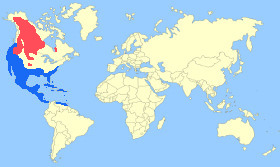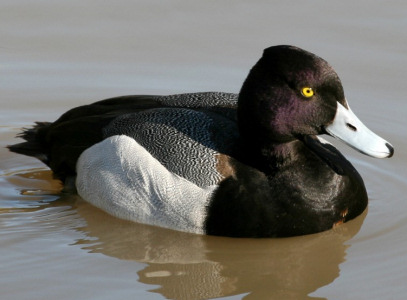Appearance:
Male - The male Lesser Scaup has a black head and neck with a purplish gloss or sometimes a greenish sheen, a small tuft at the hind-crown, yellow eyes, pale-blue beak with a black tip, a black breast, white underparts with flanks being white with some vermiculation, tail is blackish and undertail is blackish-brown, a whitish-grey back with dark vermiculations, and legs and feet are greyish-green. The lesser Scaup is smaller but very similar in appearance to the Greater Scaup.
Female - The female has a dark brown head, neck, breast, and back, a white band around the base of the beak, orange eyes, and a white belly and underparts.
Eclipse - The male in eclipse plumage is much duller than in its breeding plumage with a brownish-black head, neck, and breast and a brownish tinge to the rest of the plumage.
 |
 |
 |
Compare ducks with similar appearance.
Greater Scaup, Tufted Duck and Ring-necked Duck.
Size: - Typical Adult is 38-48cm (15-19in).
Food: - Mussels, molluscs, aquatic plant seeds, sedges, and aquatic insects.
Habitat/Range: - Inland lakes, ponds, rivers, lagoons, and bays in North America - Alaska and Canada. Winters further south to Central America, West Indies, and Venezuela.

 Breeding Habitat/Resident,
Breeding Habitat/Resident,  Migration or Winter Area.
Migration or Winter Area.Breeding Season: - Mid-May in south, mid-June further north.
Eggs: - 9 to 11 (olive-buff colour).
Notes: - The Lesser Scaup is a small North American diving duck which is sometimes called the Little Bluebill or Broadbill. It is the most common diving duck in North America.
Conservation status (IUCN 3.1):
Least Concern.
Classification: - Family: Anatidae,
Subfamily: Aythyinae, Genus: Aythya.







































